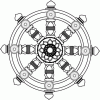This sutta of the Pali cannon of Theravada Buddhism, the Kaccayanagotta Sutta (or Kaccayana Gotta Sutta), presents at the same time the ultimate meaning of Right View in the Noble Eightfold Path, a fundamental example of the application of the Middle Way, and a description of what is called in other places The Twelve Links of Dependent Origination (a.k.a. The Twelve Links of Dependent Arising, a.k.a. The Twelve Links of Interdependent Co-Arising). It has an equivalent in the Chinese canon—Samyukta Agama 29, also known as The Sutra on the Middle Way.1
The Kaccayanagotta SuttaThe Blessed One was dwelling at Savatthi2... Then Venerable Kaccayana Gotta3 approached the Blessed One and, after prostrating before him, sat to one side. As he was sitting there, he asked the Blessed One: "Right view, right view," it is said, O Lord. But where is there right view?"4"People in general,5 Kaccayana, tend to believe in one of two views, in existence or in non-existence.6 But for him who, with the highest wisdom, sees the coming-to-be7 of the world as it really is, the 'non-existence of the world' is not appropriate,8 and for him who, with highest wisdom, sees the passing away of the world as it really is, 'existence of the world' is not appropriate. "People in general, Kaccayana, grasp after theories and are fettered by dogmas. But he who sees phenomena as they really are does not go along with that theory-grasping, that mental fixation and dogmatic supposition, does not cling to it, does not become involved with it, does not affirm 'This is my self.' He is fully certain that whatever arises is merely dukkha (Pali; Skt. duhka) arising, that whatever passes away is merely dukkha passing away,9 and such knowledge is directly his own, not depending on anyone else. This, then, is where there is right view."'All exists'—Kaccana, this is one extreme. 'All does not exist'—this is the second extreme.10 Avoiding both extremes, the Tathagata teaches the dhamma by the way of the middle:11 From ignorance12 as a condition come volitional activities.13 From volitional activities as a condition comes consciousness.14 From consciousness as a condition comes mind-and-body.15 From mind-and-body as a condition comes the sixfold base of the senses.16 From the sixfold base of the senses as a condition comes contact.17 From contact as a condition comes sensations.18 From sensations as a condition comes craving.19 From craving as a condition comes grasping.20 From grasping as a condition comes 'coming to be.'21 From 'coming to be' as a condition comes birth.22 From birth as a condition, come aging and death, sorrow, lamentation, pain, distress, and despair.23 Such is the origination of this entire aggregate mass of dukkha.24 "Now from the remainder-less fading and cessation of that very ignorance comes the cessation of volitional activities. From the cessation of volitional formations comes the cessation of consciousness. From the cessation of consciousness comes the cessation of mind-and-body. From the cessation of mind-and-body comes the cessation of the the sixfold base of the senses. From the cessation of the the sixfold base of the senses comes the cessation of contact. From the cessation of contact comes the cessation of sensations. From the cessation of sensations comes the cessation of craving. From the cessation of craving comes the cessation of grasping. From the cessation of grasping comes the cessation of 'coming to be.' From the cessation of 'coming to be' comes the cessation of birth. From the cessation of birth, then aging and death, sorrow, lamentation, pain, distress, and despair all cease. Such is the cessation of this entire aggregate mass of dukkha."25 |

